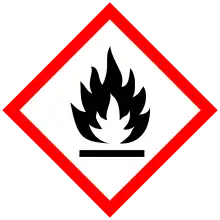 | |
| Names | |
|---|---|
| Preferred IUPAC name
Fluorocyclohexane | |
| Other names
Cyclohexyl fluoride | |
| Identifiers | |
3D model (JSmol) |
|
| ChemSpider | |
| ECHA InfoCard | 100.006.141 |
| EC Number |
|
PubChem CID |
|
CompTox Dashboard (EPA) |
|
| |
| |
| Properties | |
| C6H11F | |
| Molar mass | 102.152 g·mol−1 |
| Appearance | Colorless liquid |
| Density | 0.9280 g/mL |
| Melting point | 13 °C (55 °F; 286 K) |
| Boiling point | 103 °C (217 °F; 376 K) |
| Insoluble | |
| Hazards | |
| GHS labelling: | |
  | |
| Danger | |
| Flash point | 5 °C (41 °F; 278 K) |
| Related compounds | |
Related compounds |
Chlorocyclohexane Bromocyclohexane Iodocyclohexane |
Except where otherwise noted, data are given for materials in their standard state (at 25 °C [77 °F], 100 kPa).
Infobox references | |
Fluorocyclohexane is an organofluorine compound with the chemical formula (CH2)5CHF.[1][2][3]
Synthesis
Fluorocyclohexane is prepared by reaction of cyclohexanol with hydrogen fluoride.[4]
Safety
The compound causes serious skin and eye irritation, and may also cause respiratory irritation.[1]
See also
References
- 1 2 "Fluorocyclohexane, 97%, Thermo Scientific Chemicals, Quantity: 5 g | Fisher Scientific". Fisher Scientific. Retrieved 21 June 2023.
- ↑ "Fluorocyclohexane 372-46-3 | TCI AMERICA". TCI Chemicals. Retrieved 21 June 2023.
- ↑ Dictionary of Organic Compounds. CRC Press. 1996. p. 3180. ISBN 978-0-412-54090-5. Retrieved 21 June 2023.
- ↑ Olah, George A.; Watkins, Michael (1978). "Fluorinations with Pyridinium Polyhydrogen Fluoride Reagent: 1-Fluoroadamantane". Organic Syntheses. 58: 75. doi:10.15227/orgsyn.058.0075.
This article is issued from Wikipedia. The text is licensed under Creative Commons - Attribution - Sharealike. Additional terms may apply for the media files.